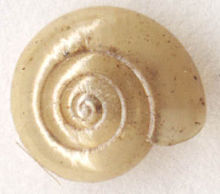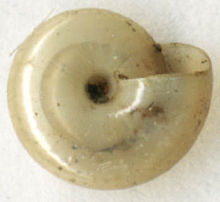Cellar gloss snail
| Cellar gloss snail | ||||||||||||
|---|---|---|---|---|---|---|---|---|---|---|---|---|

Cellar gloss snail ( Oxychilus cellarius ) |
||||||||||||
| Systematics | ||||||||||||
|
||||||||||||
| Scientific name | ||||||||||||
| Oxychilus cellarius | ||||||||||||
| ( OV Müller , 1774) |
The cellar gloss snail ( Oxychilus cellarius ) is a land snail from the family of the gloss snail (Oxychilidae); this family belongs to the subordination of land snails (Stylommatophora). It can be found quite often, especially in the cultural area. The Association of German Cave and Karst Researchers named this snail Cave Animal of the Year 2015.
features
The right-hand winding case is almost disc-shaped with only a very little raised thread. It measures 9 to 11 mm, rarely up to 14 mm in diameter, and 4.5 to 6 mm in height. It has 5.5 to 6 turns that increase slowly and regularly. The last turn is not much wider. It is significantly less than twice as wide as the previous turn. The mouth opening is transversely elliptical, apart from the incision of the previous turn. The edge of the mouth is straight and pointed. The navel is small, funnel-shaped and open.
The peel is grayish yellow on the upper side, and on the underside much lighter and light yellowish. Accordingly, the top is transparent and the bottom is opaque. The surface is almost smooth and shiny. Only weak growth lines are formed.
The body is gray-blue, the foot light gray. More rarely, the entire case is light yellow; then the body of the animal is also light yellow. There are also darker animals. In the male tract of the hermaphroditic genital apparatus, the spermatic duct (vas deferens) is moderately long to long and tortuous. It penetrates apically into the short, U-shaped epiphallus. In the area of the penis sheath and immediately before entering the epiphallus, it is connected to the penis by tissue. The epiphallus enters the penis in front of the apex. A short blind sac (caecum) is formed directly apically on the penis, to which the penis retractor muscle attaches. The penis is twice as long as the epiphallus and moderately thick. Longitudinal folds that are straight or slightly wavy are formed in the interior of the penis. In the upper third, the folds dissolve into a series of papillae. In the lower third, the penis is surrounded by a tissue cover (penis cover). In the female part, the free fallopian tube (oviduct) is very short and the vagina is very long. The perivaginal gland surrounds the upper part of the vagina and the basal part of the free fallopian tube, as well as the base of the stem of the spermathec. The stem is moderately long and thin. The bladder is elongated and reaches the egg duct (spermoviduct). The penis and vagina open into a short atrium.
Similar species
The last turn of the cellar gloss snail is somewhat narrower than that of the large gloss snail ( Oxychilus draparnaudi ). The latter species is also slightly larger on average. The Swiss gloss snail ( Oxychilus navarricus ) and the garlic gloss snail ( Oxychilus alliarius ) are much smaller and have a much more elevated thread.
Geographical distribution and habitat
The distribution area of the species includes Western Europe (Iberian Peninsula, France, Benelux countries, British Isles including the Hebrides , Orkney Islands and Shetland Islands ), Central Europe (here including Germany, Switzerland, the Czech Republic, Austria, Slovenia and parts of Croatia) as well Parts of northern Europe (Scandinavia along the Norwegian coast to the Arctic Circle and beyond, southern Sweden, southern coast of Finland). The eastern limit of distribution runs through Poland and western Slovakia . In Eastern Europe, there are otherwise only isolated occurrences in the Baltic States , Western Russia and the Ukraine . In the south the limit of distribution runs roughly in the middle of the Italian boot, in the Balkans there is an isolated occurrence in Serbia. In Switzerland it rises to 1,800 m above sea level. However, the species has now been introduced almost worldwide
The species occurs in damp deciduous forests under the leaves, dead wood, rock rubble and in caves, but the species is also very common in cultivated land, gardens, backyards and parks, under brick rubble, in damp cellars, modern wood and piles of rubbish, also in caves and Cellars (name!). The species also tolerates lime-free soils and comes e.g. B. in Great Britain in heathland, which are otherwise inhabited by very few species of snail.
Reproduction and way of life
The eggs are laid between February and October. An individual lays between 25 and 45 eggs. The eggs are 1.3 to 1.5 mm in diameter. They are smooth and milky white. The young hatch after 12 to 16 days. They reach sexual maturity in the following year. According to Ewald Frömming, however, only 7 to 14 eggs should be laid. According to him, the eggs have a diameter of 1.4 to 1.8 mm.
According to many authors, the species is said to be predominantly carnivorous and eat other snails and their eggs. After investigating faeces of the species, Ewald Frömming found that the animals mainly feed on plants and detritus. He found next to plant debris, plant hair and pollen, z. B. also many quartz grains, which clearly indicate soil damage, including the soil flora and fauna. The cellar gloss snail also eats the egg clutches of larger slugs such as slugs. B. the Spanish slug ( Arion vulgaris ).
Taxonomy
The taxon was set up in 1774 by Otto Friedrich Müller in the original combination Helix cellaria . The taxon is widely recognized.
Some authors divide the genus Oxychilus into several sub-genera. The cellar gloss snail is assigned to the nominate sub-genus Oxychilus (Oxychilus) in this classification . It is the type species of the genus (and subgenus) Oxychilus Fitzinger, 1833.
Danger
The species is a very common species in the British Isles. In Germany it is part of the warning list.
literature
- Klaus Bogon: Land snails biology, ecology, biotope protection. 404 p., Natur Verlag, Augsburg 1990, ISBN 3-89440-002-1 , p. 204/05.
- Michael P. Kerney, RAD Cameron & Jürgen H. Jungbluth: The land snails of Northern and Central Europe. 384 pp., Paul Parey, Hamburg & Berlin 1983, ISBN 3-490-17918-8 , p. 170.
Individual evidence
- ↑ Jürgen H. Jungbluth, Dietrich von Knorre: Trivial names of land and fresh water mollusks in Germany (Gastropoda et Bivalvia). Mollusca, 26 (1): 105-156, Dresden 2008 ISSN 1864-5127 , p. 122.
- ^ Adolf Riedel: Revision of the zonitides of Poland (Gastropoda). Annales Zoologici, 16 (23): 362-464, Posen 1957 PDF , pp. 407-410.
- ↑ Anatolij A. Schileyko: Treatise on Recent Terrestrial Pulmonate Molluscs Part 10 Ariophantidae, Ostracolethidae, Ryssotidae, Milacidae, Dyakiidae, Staffordiidae, Gastrodontidae, Zonitidae, Daudebardiidae, Parmacellidae. Ruthenica, Supplement 2 (10): 1307–1488, Moscow 2003, ISSN 0136-0027 , p. 1444. ( Oxychilus (Oxychilus) cellarius )
- ↑ a b c Francisco W. Welter-Schultes: European non-marine molluscs, a guide for species identification = identification book for European land and freshwater mollusks. A1-A3 S., 679 S., Q1-Q78 S., Göttingen, Planet Poster Ed., 2012 ISBN 3-933922-75-5 , ISBN 978-3-933922-75-5 (S. 379)
- ^ Rosina Fechter and Gerhard Falkner: Molluscs. 287 p., Mosaik-Verlag, Munich 1990 (Steinbach's Nature Guide 10) ISBN 3-570-03414-3 , p. 180
- ^ Ewald Frömming: Biology of the Central European Landgastropods. 404 S., Duncker & Humblot, Berlin, 1954, pp. 97-100.
- ↑ Ted von Proschwitz: Oxychilus cellarius (Muller) and Oxychilus draparnaudi (Beck) as predators on egg-clutches of Arion lusitanicus Mabille. Journal of Conchology, 35: 183-184, London 1994 ISSN 0022-0019
- ↑ Otto Friedrich Müller: Vermium terrestrium et fluviatilium, seu animalium infusoriorum, helminthicorum, et testaceorum, non marinorum, succincta historia. Volume alterum. SI-XXXVI, 1-214, Heineck & Faber, Havniae / Copenhagen & Lipsiae / Leipzig, 1774 Online at Biodiversity Heritage Library (p. 28).
- ↑ AnimalBase: Oxychilus cellarius (OV Müller, 1774)
- ↑ Fauna Europaea: Oxychilus (Oxychilus) cellarius (OF Muller, 1774)
- ↑ Oxychilus cellarius (OV Müller, 1774)
- ↑ a b Vollrath Wiese: The land snails of Germany. 352 pp., Quelle & Meyer, Wiebelsheim 2014, ISBN 978-3-494-01551-4 (p. 185)



